Chapter: Software Project Management
Software Project Management: Monitoring and Control
MONITORING AND CONTROL
1 Creating Framework
2 Collecting The Data
3 Visualizing Progress
4 Cost Monitoring
5 Earned Value
6 Prioritizing Monitoring
7 Getting Project Back To Target
8 Change Control
9 Managing Contracts
10 Types Of Contract
11 Stages In Contract Placement
12 Typical Terms Of A Contract
13 Contract Management
14 Acceptance
1. Creating framework
Project control cycle
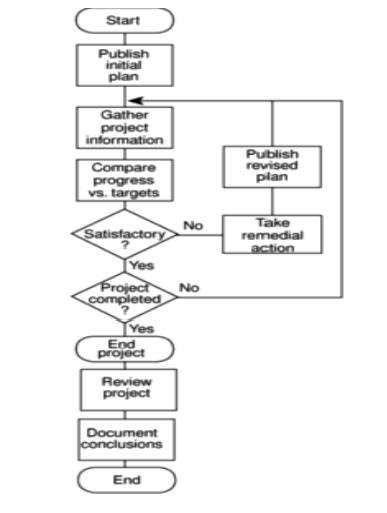
Responsibility
Project
steering committee
Project
board
Reporting
formal or informal
Assessing progress
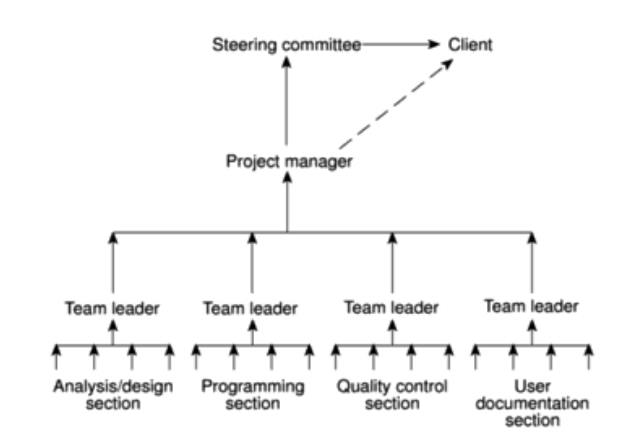
Setting checkpoints
Regular
Tied to
specific events
Taking snapshots
Review
points or control points
Assess
progress daily
2 Collecting data
Contents
Partial
completion reporting
Risk
reporting
Time Sheet:
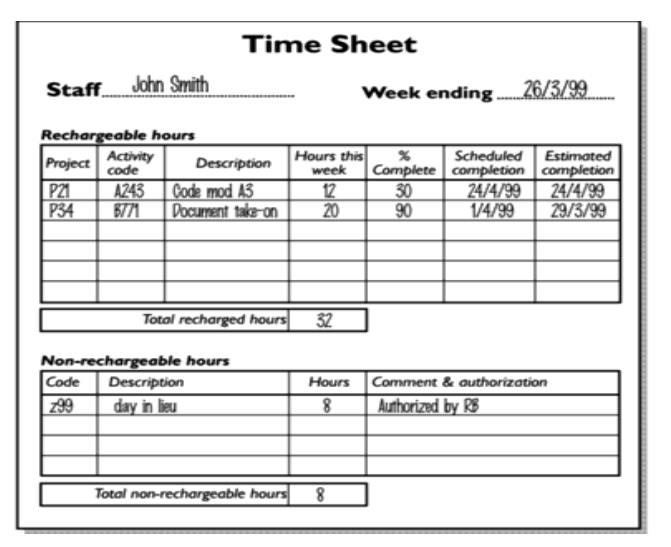
Activity Assessment Sheet:
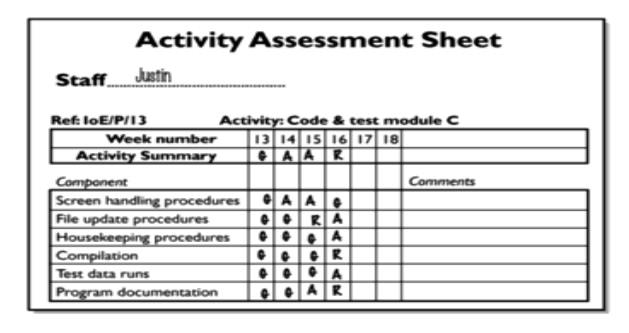
3. Visualizing progress:
Gantt chart:

Slip chart
provides
visual indication of activities which are not progressing in schedule
Ball charts -Shows whether or not targets
have been met

Time lining:
Records
and displays how the targets have changed throughout the duration of project
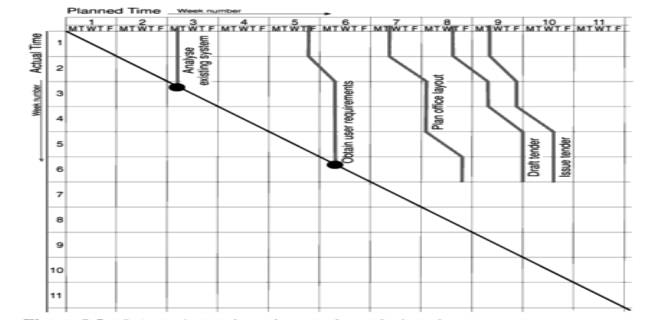
4. Cost monitoring:
Expenditure monitoring
Framing cumulative expenditure chart
Projected future costs
Computer-based
planning tool
Tracking expenditure
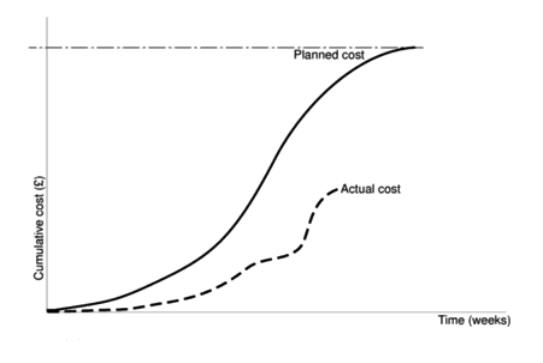
5. Earned value: Earned value analysis
Assigns a
value to each task
BCWS
Baseline
budget
BCWP-budgeted
cost of work performed
Technique
The 0/100
technique
The 50/50
technique
The mile
stone technique
The baseline budget
First
stage in baseline budget
Forecast
growth
Specify
overall system
Expenditure chart
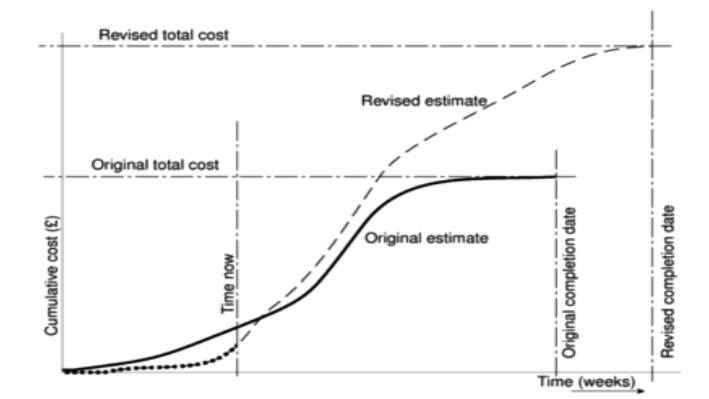
Baseline budget calculation
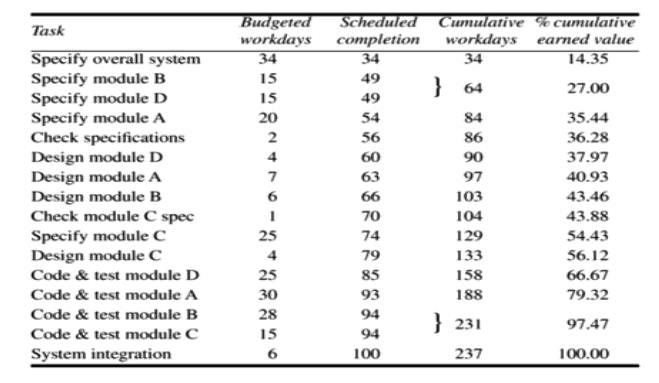
Earned value tracking chart
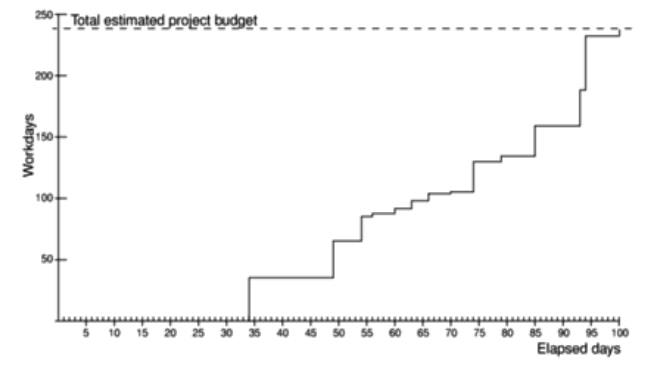
Performance statistics from earned value chart
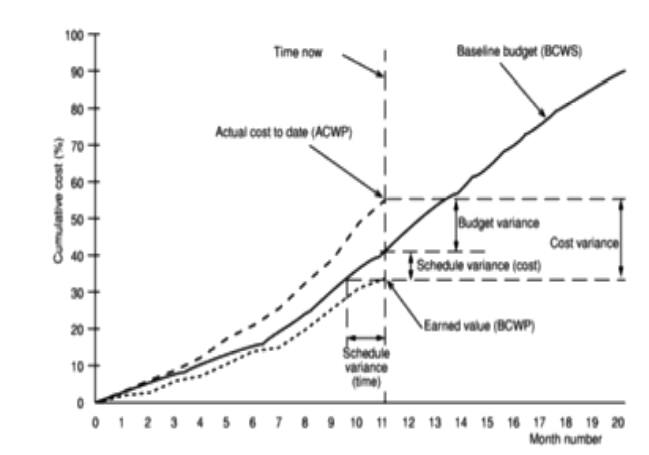
Budget
variance
Schedule
variance
Coast
variance
Performance
ratios Schedule performance index SPI=BCWP/BCWS
Earned value charts with revised forecasts
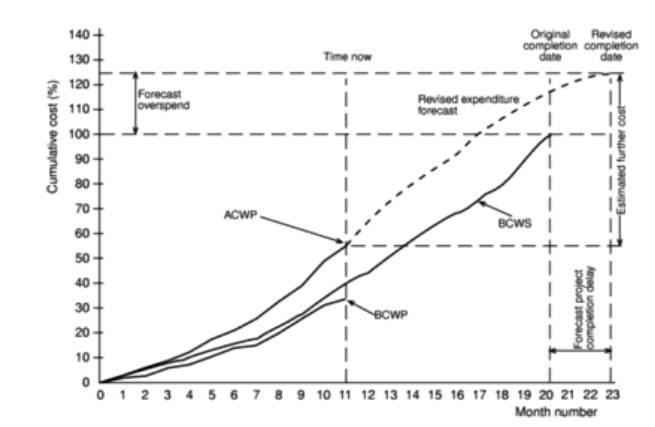
Definition:
Earned
value analysis is a method of performance measurement. Earned value integrates
cost, schedule and scope and can be used to forecast future performance and
project completion dates. It allows projects to be managed better – on time, on
budget.
Three quantities form the basis for cost
performance measurement using Earned Value
Management. They are
Budgeted Cost of Work Scheduled (BCWS) or Planned
Value (PV)
Budgeted Cost of Work Performed (BCWP) or Earned
Value (EV) and
Actual Cost of Work Performed (ACWP) or Actual Cost
(AC).
The above
quantities are defined below.
Budgeted Cost of Work Scheduled (BCWS) or Planned Value (PV)
– The sum
of budgets for all work packages scheduled to be accomplished within a given
time period.
Budgeted Cost of Work Performed (BCWP) or Earned Value (EV)
– The sum
of budgets for completed work packages and completed portions of open work
packages.
Actual Cost of Work Performed (ACWP) or Actual Cost (AC)
– The
actual cost incurred in accomplishing the work performed within a given time
period. For equitable comparison, ACWP is only recorded for the work performed
to date against tasks for which a BCWP is also reported.
From
these three quantities we can determine our total program budget as well as
make a determination of schedule and cost performance and provide an estimated
cost of the project at its completion. Additional terms are defined to record
cost and schedule performance and program budget:
Schedule Variance (SV)
– The
difference between the work actually performed (BCWP) and the work scheduled
(BCWS). The schedule variance is calculated in terms of the difference in
dollar value between the amount of work that should have been completed in a
given time period and the work actually completed.
Cost Variance (CV)
– The
difference between the planned cost of work performed (BCWP) and actual cost
incurred for the work (ACWP). This is the actual dollar value by which a
project is either overrunning or under running its estimated cost
Two Performance Ratios:
Cost Performance Index (CPI)
– The ratio of cost of work performed (BCWP) to actual cost (ACWP). CPI
of 1.0 implies that the actual cost matches to the estimated cost. CPI greater
than 1.0 indicates work is accomplished for less cost than what was planned or
budgeted. CPI less than 1.0 indicates the project is facing cost overrun.
Schedule Performance Index (SPI)
– The ratio of work accomplished (BCWP) versus work
planned (BCWS), for a specific time period. SPI indicates the rate at which the
project is progressing.
Estimate at Completion (EAC)
– It is a forecast of most likely total project
costs based on project performance and risk quantification. At the start of the
project BAC and EAC will be equal. EAC will vary from BAC only when actual
costs (ACWP) vary from the planned costs (BCWP).
Earned Value
Management Formula:
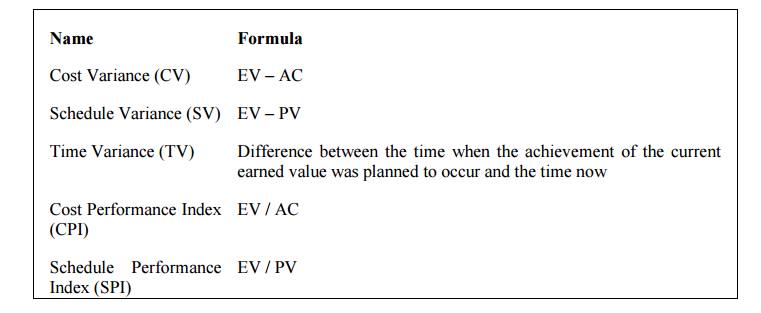
6 Prioritizing monitoring
Critical path activities
Activities with no free float
Activities with less than a specified float
High risk activities
Activities using critical resources
7 Getting the project back to target:
Strategies
Shortening the critical path
Altering the activity precedence requirements
Shorten critical path
Speed up
non-critical path activities
Fact
finding
Time/cost
trade off
Reconsider the precedence requirements
Normal working practices
Subdivide to components
Assess changes
8 Change control:
A change in program specification
Change program design and then code
Change control procedures
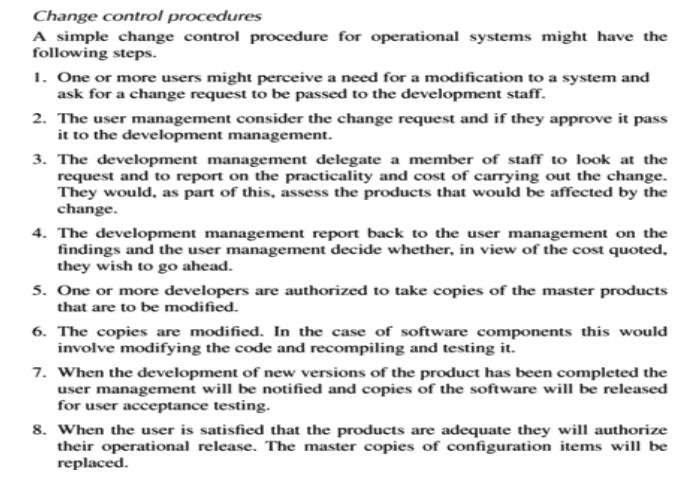
The role of configuration librarian:
Identifying
items that need to be subject to change control
Management
of a central repository of the master copies of software and documentation
Administering
change procedure.
Maintenance
of access records
Typical change control process
One or
more users might perceive the need for a change
User
management decide that the change is valid and worthwhile and pass it to
development management
A
developer is assigned to assess the practicality and cost of making the change
Development
management report back to user management on the cost of the change; user
management decide whether to go ahead
One or
more developers are authorized to make copies of components to be modified
Copies
modified. After initial testing, a test version might be released to users for
acceptance testing .
When
users are satisfied then operational release authorized – master configuration
items updated .

Change control and configuration management
Change control
– Set of
procedures to ensure that changes made only after a consideration of the full
impacts.
Configuration management
– Version
control to ensure that all changes are properly recorded and managed – and so
that knock-on effects on other projects can be identified.
9. Managing contracts:
Contract administration is the management of contracts made with customers, vendors,
partners, or employees.The personnel involved in Contract Administration
required to negotiate, support and manage effective contracts are expensive to
train and retain. Contract management includes negotiating the terms and
conditions in contracts and ensuring compliance with the terms and conditions,
as well as documenting and agreeing on any changes or amendments that may arise
during its implementation or execution. It can be summarized as the process of
systematically and efficiently managing contract creation, execution, and
analysis for the purpose of maximizing financial and operational performance
and minimizing risk.
CHANGE MANAGEMENT:
There may be occasions where what is agreed in a contract needs
to be changed later on. A number of bases may be used to support a subsequent
change, so that the whole contract remains enforceable under the new
arrangement.
A change may be based on:
A mutual agreement of both parties to
vary the contract, outside the framework of the existing contract. This would
be an independent basis for changing the contract.
A unilateral decision to vary the
contract, contemplated and allowed for by the existing contract. This would
normally have notice periods for fairness and often the right of the other,
especially in consumer contracts, to cease the contractual relationship. Be
careful that any one-way imposition of change is contractually justified,
otherwise it may be interpreted as a repudiation of the original contract,
enabling the other party to terminate the contract and seek damages.
A bilateral decision to vary the
contracting, within the variation or change control process outlined in the
existing contract. These are often called change control provisions.
10 Types of contract
Completed
software application
Bespoke
Off-the
shelf
Customized
off-the shelf
Payment
calculation
Fixed
price contracts
Time and
material contracts
Fixed
price per delivered unit contracts
Fixed
price contracts:
Advantage:
Known customer
expenditure
Supplier
motivation
Disadvantage
Higher
prices to allow for contingency
Difficulties
in modifying
Upward
pressure on the cost changes
Thread to
system quality
Time and
material contracts
Advantage:
Ease of
changing requirements
Lack of
price pressure
Disadvantage:
Customer
liability
Lack of
supplier
Fixed
price per unit delivered contracts:
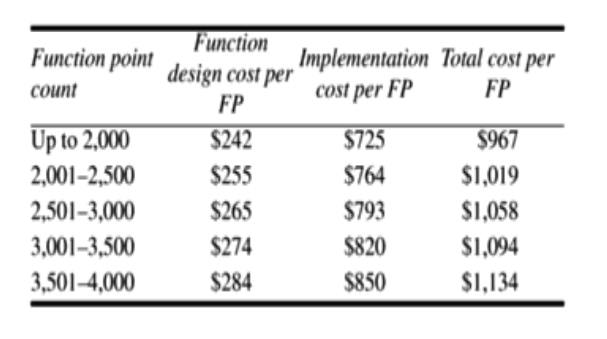
Fixed price per unit delivered contracts
Advantage:
Customer
understanding
Comparability
Emerging
functionality
Supplier
efficiency
Life
cycle change
Disadvantage:
Difficulties
with s/w size measurement
Changing
Based on contractor selection
Open
tendering
Restricted
negotiated
11. Stages in contract placement
Requirement analysis
OR
Mandatory
Desirable
Sections in requirement document:

Evaluation plan:
Draw up
plan account to proposals
Opposed
to off the shelf application
Mandatory
requirements are identified
Value for
money
12. Typical
terms of a contract:
Definitions
Forms of
a agreement
Goods and
services to be supplied
Services
to be provided
Ownership
of the software
Acceptance
Acceptance
tests
Internal
test plans
Pitfalls
Very
short warranty period
STAGES
IN CONTRACT PLACEMENT
AND TYPICAL TERMS
OF A CONTRACT
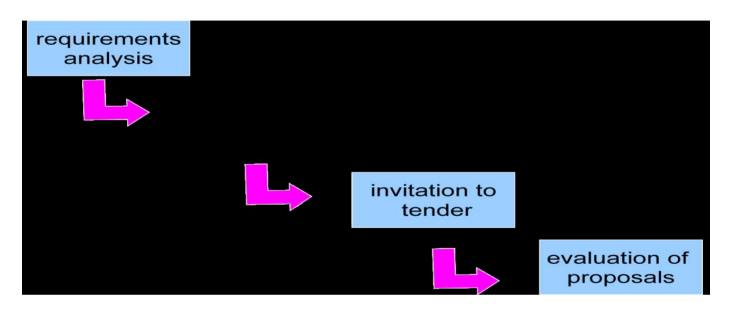
Requirements document
Introduction
Description
of existing system and current environment
Future
strategy or plans
System
requirements -
–
Mandatory/desirable features
Deadlines
–
Functions in software, with necessary inputs and outputs
–
Standards to be adhered to
– Other
applications with which software is to be compatible
– Quality
requirements e.g. response times
Additional
information required from bidders
Evaluation plan
How are
proposals to be evaluated?
Methods
could include:
– reading
proposals
–
Interviews
–
Demonstrations
– Site
visits
–
Practical tests
Invitation to tender (ITT)
Note that
bidder is making an offer in response to ITT
Acceptance
of offer creates a contract
Customer
may need further information
Problem
of different technical solutions to the same problem
Memoranda of agreement (MoA)
Customer
asks for technical proposals
Technical
proposals are examined and discussed
Agreed
technical solution in MoA
Tenders
are then requested from suppliers based in MoA
Tenders
judged on price
Fee could
be paid for technical proposals by customer
13. CONTRACT MANAGEMENT
Contracts
should include agreement about how customer/supplier relationship is to be
managed e.g.
–
Decision points - could be linked to payment
– Quality
reviews
– Changes
to requirements
14 .ACCEPTANCE
When work
is completed, customer needs to carry out acceptance testing.
Contract
may put a time limit to acceptance testing – customer must perform testing bf
time
expired.
• Part or
all payment to the supplier should depend on acceptance testing
Acceptance
criteria are defined as “the list of requirements that must be satisfied prior
to the customer accepting delivery of the product”.
This
document defines the acceptance process, the acceptance criteria, and the
review/approval required for customer acceptance of the (Agency name) (project
name) project deliverables.
The
purpose of this document is to define a standardized Deliverable Review
Process, which will provide a structured method to support the Agency Software
Verification and Validation Plan (SVVP) to ensure that appropriate, correct,
consistent, and complete deliverables are created for the project.
This
document describes:
Goals of
the review process;
Definitions;
Meeting
participants, roles, and responsibilities;
Review
process;
Dispositions
for the review meeting; and
Review
exit criteria.
The
primary goal of the Deliverable Review Process is to detect and remove
deliverable defects as early as possible in the Software Development Life Cycle
(SDLC) process.
Secondary
goals to be attained are:
Consistency
with IEEE Std 1028-1997, Standard for Software Reviews;
Ensure
correctness, completeness, consistency, and accuracy of deliverables and
products for all life cycle activities within the development process;
Acceptance Process for Project Deliverables
The
acceptance process for (Project Name) provides a roadmap for incremental
acceptance by the customer of the software application and associated project deliverables
at the following key milestones.
Project
Phase Concept Complete
Phase
Requirements Complete
Phase
Design Complete
Phase
Application Ready For Pilot
Phase
Application Ready For Statewide Rollout
Phase
Complete
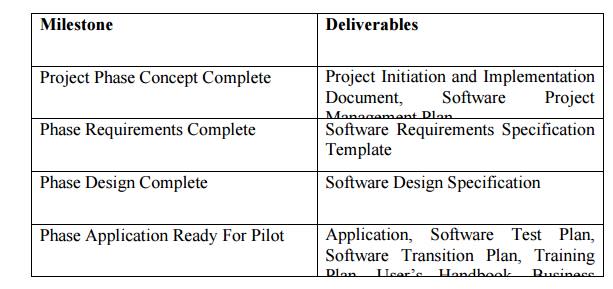
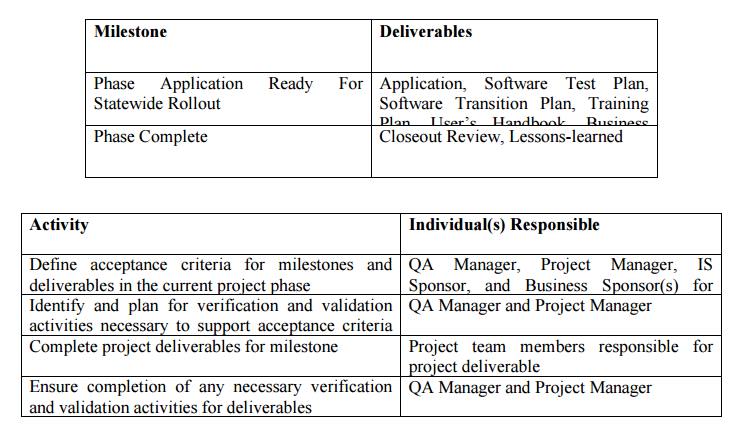
Acceptance Criteria for
Milestones and Deliverables
The
acceptance criteria in the table below define the conditions under which the
PROJECT Business Sponsor(s), the PROJECT IS Sponsor, and the Project Manager
agree that they will accept completion of the milestones and deliverables
subject to these acceptance criteria.
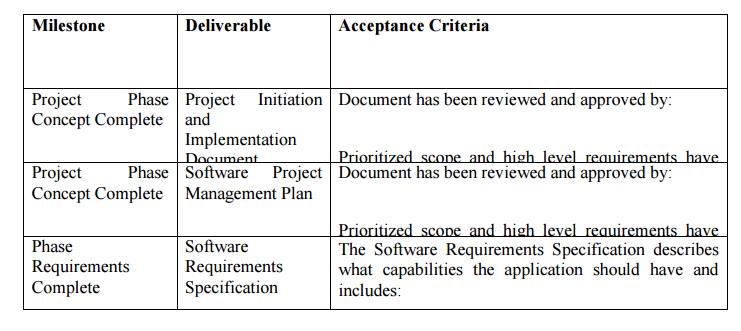
Related Topics